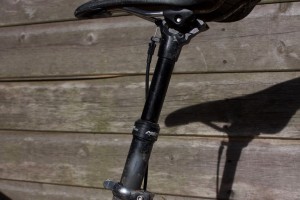SDG’s Tellis dropper post is one that’s gained a reputation for being super reliable. After six years the brand has brought updates to the dropper and while most of them are internal, the Tellis V2 continues to carry its notoriety for longevity while hosting more travel and greater smoothness. The new head design, however, throws an interesting curveball in a move that’ll work fine for many but be a real pain for others.
SDG Tellis V2 - Technical details
Many of the updates found on the second iteration of the Tellis are found inside with the brand claiming that its IGUS bushings, Trelleborg main seal, and the Wintek cartridge (which is said to be the most reliable in the biz) get rid of some of the maintenance based issues found on other droppers. With this, SDG states that fewer moving parts provide fewer chances of failure.
Other internal upgrades come as a new polycarbonate keyway system that uses copper shims for durability while being credited with minimising rotational play between the stanchion and the dropper’s body. The Tellis is now travel-adjustable too with five, 10, and 20mm shims included in the box. It’s always great to see some level of travel adjustment in a dropper post as it allows the rider to really fine-tune the drop provided for their inseam, getting the absolute most out of the dropper without compromise.
Elsewhere, the green actuator at the bottom of the post has been shrunk by 5mm to help it fit in more frames and the stack has been reduced by 10mm. The 26mm diameter stanchion is 3D forged and SDG says that the dropper has been tested down to -20 Celsius.
Although we love upgrades for the sake of durability, the most interesting feature of the Tellis V2 is its new side access rail clamp. The important thing about this clamp is that it allows for adjustment of the saddle’s angle but it works to keep hard metal allen keys well away from the post’s stanchion. As we all know, it’s far too easy to score a dropper’s stanchion when haphazardly tweaking a saddle’s angle on a traditional clamp. This head is also attributed to the lower stack mentioned before.
SDG goes on to claim that the Tellis V2 provides the largest range of travel options on the market, being available in 75, 100, 125, 150, 170, 200, and 230mm of drop. To compare, OneUp Component’s newest V3 Dropper post offers six travel options from 90 up to 240mm. The Tellis can also be picked up in 30.9, 31.6, and 34.9 diameters, so unlike the OneUp dropper, it can’t fit into slim gravel or cross-country bike frames.
On test, we’ve got the 170mm, 30.9mm diameter post and I rode it with SDG’s Tellis lever.
SDG Tellis V2 - Installation
Installation of the Tellis V2 is very similar to most other cable-actuated droppers on the market. Simply pop the ball end into the dropper’s green actuator and clamp the free end of the cable into the handlebar remote.
However, things really change when it comes to clamping a saddle. I’ll admit, I’ve always struggled to some degree with the monumental faff that clamping a saddle to a fresh dropper usually poses. But SDG has worked out a clever way of making it super simple as there’s no real balancing act as there is with regular clamps.
With this dropper, each rail clamp is separate from one another, so the user can install one side and then the other. As long as each clamp is loose, leaving a few millimeters under the clamp free, the whole assembly can slide onto the dropper post’s rails. Then, the clamps need to be tightened to 17Nm and that’s on the upper end of the rail clamp torque scale, which makes on-the-trail tweaks tricky with the typically small 5mm allen of a multi-tool.
SDG Tellis V2 - Performance
SDG’s second crack at the Tellis dropper post carries on its reputation as a workhorse dropper post. During my several months of riding with the post, it’s not missed a beat in the slightest. There may have been the odd cable tension tweak to get the dropper lever working as I would like but performance has been great and consistent from the day I took it out of the box.
One thing’s for sure, it’s a solid dropper. Free rotational movement is kept to a minimum thanks to the brand’s work to the keyways and the post is very smooth in action.
There is one niggle that’s easily overlooked and that’s in the way that its clever head and rail clamps work. In order to set the saddle angle, the head slides on a pair of rails that are convex. The issue here is that to set the nose of a saddle lower, the saddle’s rails need to slide backward on the dropper post’s convex rails. What this means in practice is that the post provides a layback, especially when installed on bikes with slack seat tube angles.
Now, the seat tube on my 2021 Canyon Spectral 29 isn’t slack by any means but I like to steepen its effective seat tube angle by slamming the saddle as far forwards as possible. However, even when the saddle is as far towards, the effective layback that the Tellis V2 provides opens up the cockpit, which goes against my objective of shortening the cockpit.
If the seat tube on your bike is steeper, this won’t affect you as much but if you’re on an older bike or just one with a slack seat tube, this is something that needs serious consideration before purchase.
But, as I said before, this design does provide its benefits, being easy to install while shortening the dropper’s stack height a smidgeon. However, for the Tellis’s issues, I’d rather have a system like what’s found on the Crankbrothers Highline as it’s simpler still and doesn’t affect a bike’s geometry.
In terms of measurements, the Tellis V2 is on the money. It’s nothing crazy with a super short insertion and short stack, so for those with taller seat tubes, it’s not as easy to stuff in more travel for its size but compared to posts like the Highline, it’s very similar. But notably, its collar-to-bottom measurement or maximum insertion length is competitive for the travel, measuring 276mm on this post, allowing for longer travel to be run in short-depth seat tubes. But then the Tellis’ collar is quite deep, affecting the dropper’s overall stack.
Where the post definitely has its quirks, if you’re looking for a dropper post that goes up and down consistently through a range of conditions for a long time, SDG’s Tellis V2 does exactly that. It’s smooth, clearly durable, and a very valid option for the money.
SDG Tellis V2 - Verdict
At £200 the Tellis V2 sits at a price point that’s filled with competition. e*thirteen’s Vario Infinite now comes in at a hair under £180. Although it doesn’t have quite the travel range of the Tellis V2. It does have a longer maximum insertion though, as the brand tries to pack in more travel options in a single post and I ran into reliability issues early in the test.
PNW Components’ Loam Dropper is £188 and it’s a cracking bit of kit. Its full insertion length is significantly shorter but the measurement between the bottom of the collar and the rails is 4mm taller. So while you can fit a longer travel Loam Post in the frame, the collar-to-rail measurement may become an issue.
But where the Tellis V2 falls flat is in that layback that can alter the effective geometry of a bike depending on the angle of its seat tube. For me personally, it’s the one reason why I’ll be swapping the post after this test.
Reliability is the name of the game with the SDG Tellis V2. It simply works and if you want a dropper that you don’t have to tend to while reaping the rewards of its smoothness and lack of play, it’s a great option. Although it's not doing everything to minimise its measurements with the aim of maximising travel, its figures are on point but there are cheaper posts out there that pose serious competition.















Add comment